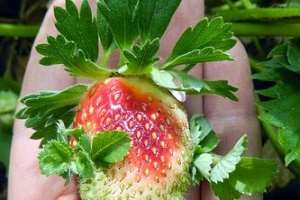We collected date on performance of sixteen cultivars or advanced selections of strawberries in the second harvest year of a matted-row trial. Some were great, and others had a few issues.

Unlike last year, when nearly all of the cultivars started to fruit at the same, there was some separation in the fruiting time of the varieties.
‘Earliglow’, and ‘Jewel’
‘Earliglow’, and ‘Jewel’, our early-season and mid-late season standards, respectively, continued to perform as expected, with yields up relative to last year and fruit size dropping off a bit, as would be expected. ‘Earliglow’ produced total yields of 9,900 lb/a with a mean berry weight of slightly less than last year, at 9.0 g/berry while Jewel produced 14,200 lb/a of fruit averaging 9.2 g/berry.
‘Galletta’
‘Earliglow’ was the first variety to ripen, with ‘Galletta’ following about 3 days later. ‘Galletta’ was developed for plasticulture, but produced sufficient runners to fill the rows in very nicely after last year’s renovation. ‘Galletta’ was still a little low-yielding in this system, producing 7,000 lb/a, but had nice-sized fruit averaging 11.1 g/berry.
‘Laurel’
‘Laurel’ was another early-season variety, and continued to perform well, yielding 13,100 pounds per acre, and nice-sized berries averaging 9.8 g/berry. Flavor is good, but not excellent. It is resistant to foliar diseases. Unfortunately, it isn’t available from any U.S. nurseries that I know of.
‘Sonata’
‘Sonata’ was the top-yielder, producing 18,800 lbs/acre of average-tasting fruit, averaging 9.3 g/berry, and fruiting in the mid-season. Flavor is average.
‘Rubicon’
‘Rubicon’ produced fruit at the same time as ‘Sonata’. Yields were perfectly acceptable at 11,800 lb/a, but berries were on the small side averaging only 8.8 g/berry. The fruit were tart as they were last year, but much less of the fruit was lost to gray mold, probably because we had a considerably drier harvest season.
‘Mayflower’ and ‘Jewel’
‘Mayflower’ fruited at about the same time as ‘Jewel’. Its yield increased considerably over last year, coming in at 11,900 lb/a. As happened last year, this cultivar had the highest percentage of marketable fruit compared to any other variety, at 75% marketable fruit. This is fairly impressive, especially considering that no fungicides or insecticides were applied to this plot this year. The flavor wasn’t the best, but seemed somewhat improved compared to last year.
‘Malwina’
‘Malwina’ was again in a harvest season all its own, not beginning to fruit until June 24 when only ‘Jewel’, ‘Mayflower’, and ‘Rubicon’ were still fruiting decently, and continuing to produce until July 13. A tiny percentage of the fruit (only a few berries) sprouted leaves, which is just a genetic disorder with this variety, and some of the caps looked like they were trying to mimic leaves. Seeing this does get one’s attention!
Two of the four Cornell advanced selections had good total yields, but fruit tended to be on the small side. One of the Rutgers advanced selections had amazing flavor later in the harvest season, and yields of all three were decent ranging from 7,100 to 10,000 lbs/acre.
Disease and insect incidence was fairly low overall, with the main reason for unmarketable fruit being small berry size.
Source: psu.edu